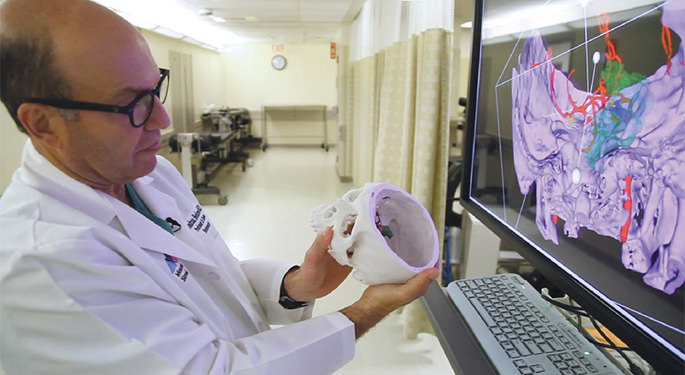
Paragangliomas
Paragangliomas, also called glomus tumors, occur in a variety of places in the head and neck. They are rarely if ever cancerous. Almost half of all paragangliomas appear in the bone on the side of the head/skull (temporal bone). These tumors are relatively simple and frequently associated with other neurological tumors that develop in embryos, such as chemodectomas and neurocristopathic tumors. At Mount Sinai, we take a multispecialty medical approach to treating paragangliomas.
Types of Paragangliomas
We categorize paragangliomas based on their locations.
- Caroid paragangliomas appear with an expanding and pulsing mass. When this paraganglioma appears as a simple, isolated lesion, you may experience relatively few symptoms. These tumors usually appears in the neck, but can extend into the space between the head and the neck. Some of most common symptoms are pain, hoarseness, fainting (syncope), difficulty swallowing (dysphagia), eye problems (Horner syndrome), and paralysis of the tongue.
- Cervical paragangliomas are slow-growing tumors that can cause palsy and spread into the skull base. It can be difficult to distinguish between tumors that affect the vagus and those that involve the carotid artery.
- Jugular paragangliomas, which are usually large, often appear with paralysis of the fourth, fifth, and 11th cranial nerves. The symptoms vary. If they paralyze the fourth nerve paralysis, it can produce double vision; if it disturbs the fifth nerve paralysis, you can have some numbness of the face; and if the tumor affects the 11th cranial nerve, you may find it hard to move your shoulder. When the tumor extends beyond the jugular foramen, it may involve the 12th cranial nerve, which can produce paralysis and/or weakness in your tongue.
- Secretory paragangliomas canoccur in up to one in eight patients and may involve the release of catecholamines. The symptoms may include headaches, hypertension or high blood pressure, palpitations, excessive sweating, and anxiety. Treatment may be difficult because it will jar the paraganglioma to release some hormones.
- Temporal paragangliomas can have one or more of the following symptoms: hearing loss, rhythmic thumping in the ear, paralysis of the face, discharge from the ear, pain, vertigo, hemorrhage from the ear (otorrhagia), lower cranial nerve paralysis, nausea and vomiting, vision problems, headaches, and changes in behavior.
- Vagal paragangliomas can cause paralysis to the lower cranial nerves (including the 10th cranial nerve, which can cause paralysis of the diaphragm), 12th cranial nerve paralysis (with paralysis of the tongue), problems in swallowing, and problems with raising your shoulder.
Since it can be difficult to distinguish between tympanic and pure jugular paragangliomas, we consider them all to be temporal paragangliomas.
Occasionally, paragangliomas appear in other places in the head and neck. We usually need to perform a biopsy to diagnose these.
Diagnostic Tests
Imaging scans can help us diagnose paragangliomas of all types. At Mount Sinai, we typically use these diagnostic test:
- Computed tomography scans helps us see whether the tumor has moved into any of the nearby bony structures including the petrous bone, temporal bone, and bones of the head and neck.
- Magnetic resonance imaging is the best diagnostic test for paragangliomas. It helps us see how big they are and whether the blood vessels have moved into adjacent structures and other vascular areas.
- Angiography demonstrates the vascularity of paragangliomas, venous drainage, and movement into vascular structures such as the jugular vein or the sigmoid sinus.
Treatment Options
At Mount Sinai, we use embolization to treat paragangliomas is embolization. This state-of-the-art technique can shrink the tumor and reduce bleeding, which makes it much easier to remove surgically. We also use angiography to provide information on the precise size and location of the tumors.
When the tumor is growing slowly and we cannot perform surgery and embolization, we may perform radiation.